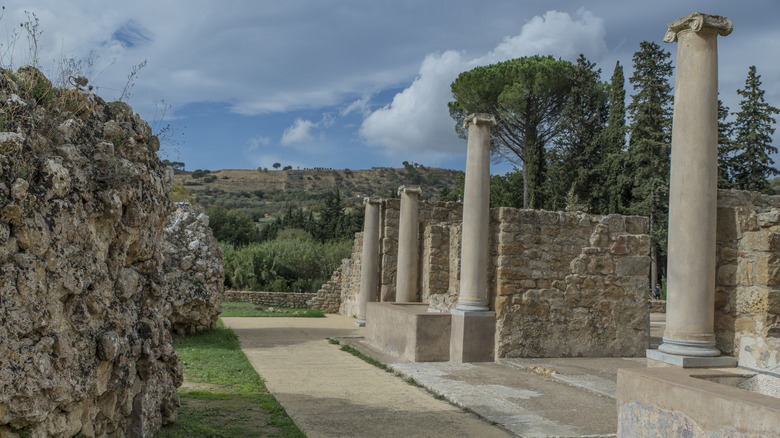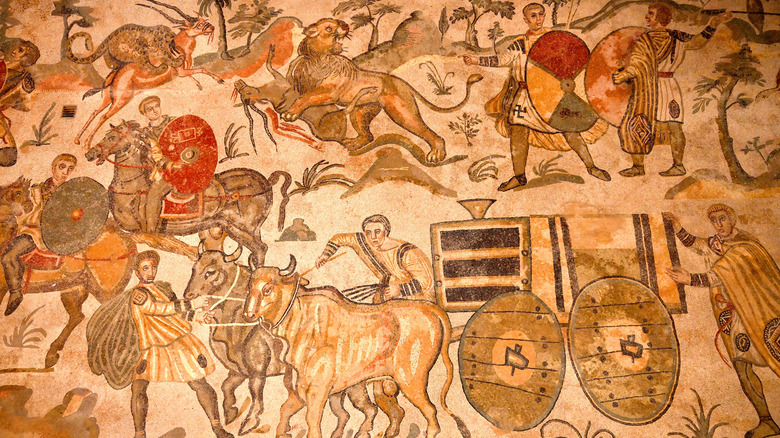This Stunning Palace In Italy Is An Open-Air Museum Full Of History, Culture, & Art
Sicily's Villa Romana del Casale is one of the best historical sites to see in Italy and a must for those interested in ancient Roman art and architecture. History lovers will be thrilled to discover the remarkably well-preserved remains of this vast archaeological site, located near the historic town of Piazza Armerina, in the valley of the Gela River. The villa contains one of the finest and most extensive collections of Roman mosaics in the world. Built between the 3rd and 4th century AD over earlier foundations, the villa was the home of an important family of high standing in the Roman Empire, evident in the richness and extravagance of the highly decorated rooms. It's thought to have belonged to a wealthy Roman senator involved in the exotic animal trade.
In 1997, it was named a UNESCO World Heritage site for housing the largest and most complex collection of Roman mosaics ever discovered. The vibrant artwork depicts everything from mythological figures to scenes of daily life in exquisite detail. The villa has survived flooding, landslides, earthquake damage, the Norman conquest, vandalism, and centuries of abandonment. But it was the 12th-century landslide from the nearby Mount Mangone which ultimately saved it. The mud buried the site, protecting the mosaics and preserving them for centuries. They remained hidden until the 19th century, when archeologists began to uncover the remains. It was Gino Vinicio Gentili who led the main excavations in the 1950s, revealing one of the greatest archaeological treasures of the Roman world.
Why the famous mosaics in Sicily are worth the trip
You don't need to be a history buff to appreciate the stunning display of Roman antiquity at Villa Romana del Casale. Over 50 rooms make up the complex layout, which provides an exciting glimpse into the elite Roman lifestyle. The visit, which takes around two to three hours, guides you over richly decorated rooms by raised walkways, which allow you to admire the mosaic floors from above. In each room, you'll see a different theme, with the stories explained on the panels along the way. Or, you can pick up an audio guide at the ticket office.
As you wander around, you'll see more than 37,000 square feet of richly decorated mosaics, created from marble and glass chips by African mosaicists. Some of the highlights include the corridor of The Great Hunt, a 60-metre-long gallery showing the capture and transport of exotic animals destined for the bloodthirsty but popular gladiator arenas of Rome. Another is the Chambre of the Ten Maidens (sometimes called the "Bikini Girls"), which features women competing in various athletic events. There's also the Great Dining Hall, which shows the Twelve Labours of Hercules, filled with battles with mythological beasts. Located near the villa entrance, you'll see the remains of the luxurious bath complex, where you can see excellent examples of underfloor heating channels and the pipes of the advanced hypocaust system, which contained hot water to keep the residents warm.
Planning your trip to Villa Romana del Casale
If you're flying into Sicily, the nearest airport is Catania-Fonterossa on the east side of the island. It's Sicily's busiest airport and is around 58 miles from the beautiful Italian town of Piazza Armerina, the closest city to Villa Romana del Casale. The other nearby airports include Palermo and Comiso. All of these airports have regular flights to and from other European cities. If you're staying in Sicily's capital, Palermo, the villa is around a 1.5-hour drive. If you're already staying in Piazza Armerina, it's a 3.7-mile drive with paid parking next to the site, or you can take a local bus. You'll also find guided tours from major Sicilian cities. Tickets cost €14 and the site is open daily.
Although the villa is the main attraction in the area, it would be a shame not to see some of the other architecture while you're in town. There's the Cathedral Basilica, which looms over Piazza Armerina with its large yellow sandstone dome. Or a short walk away, you'll find the Palazzo Trigona, a 17th-century Baroque palace that houses the archaeological museum and, within it, finds from the villa's excavations. No trip would be complete without sampling some of Italy's must-try dishes, and the streets of Piazza Armerina are lined with trattorias and cafés serving classic Sicilian specialities like arancini and granita.


